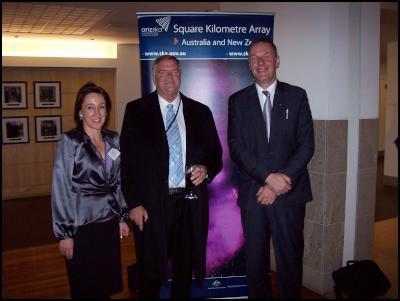Telescope Project Benefits New Zealand and Australia
“Journey to the Beginning of Time” Pauses in Washington
An “out of this world” event was held at the Australian Embassy in Washington, D.C.
An enormous radio telescope that will allow astronomers to detect signals from the furthest points of the universe (and therefore discover events from its very beginning) is being built in remote Western Australia. It is an international scientific project prominently involving Australian and New Zealand scientists, engineers, and businesses.
The Square Kilometre Array (SKA) Project was described by astronomer Dr. Brian Boyle at an event at the Australian Embassy in Washington. The event was co-hosted by Australian Ambassador Kim Beazley and New Zealand Embassy Deputy Chief of Mission Jane Coombs. Dr. Boyle’s audience included scientists and officials from US space and physical science agencies who met with the science and technology representatives of the host embassies in a reception after the talk. The SKA Project will require Australian and New Zealand technical expertise to respond to the challenges of providing self-sustaining electric power to the equipment. It also develops computer networking and data storage technologies to connect the numerous antennas composing the SKA in a remote and austere location, with minimal impact on the environment.

Click for big version
NZ DCM Jane Coombs, Australian Amb to US Kim Beazly, and Dr. Brian Boyle at SKA event Washington DC
New Zealand DCM Jane Coombs said “New Zealand is very excited about the Square Kilometre Array and the potential that it offers the world. The SKA will be unparalleled in its provision of cutting edge science and innovative technological advancements, and in its opportunities for scientists, engineers, and technology industries. It will push technological horizons, drive innovation, and contribute to economic growth around the world.”
Ms. Coombs went on to say that “the SKA offers many opportunities for New Zealand scientists, engineers and businesses to work with their Australian and US counterparts – allowing New Zealand to share its expertise in such areas as super-computing, and to learn from the expertise of Australia and the US, for example with the significant radioastronomy possibilities provided by the Australian SKA Pathfinder (or “ASKAP”) and the collaboration between the US, Australia, and India on the Murchison Widefield Array.
Charles Sneiderman, a physician and scientist, recently retired from the US National Institutes of Health. He is married to reporter Connie Lawn.
ENDS


 Binoy Kampmark: Join The Army; Travel To Exotic, Distant Lands; And Radicalise
Binoy Kampmark: Join The Army; Travel To Exotic, Distant Lands; And Radicalise Ramzy Baroud: Letters from Gaza – ‘Alhamdulillah. We Are Not Okay’
Ramzy Baroud: Letters from Gaza – ‘Alhamdulillah. We Are Not Okay’ Ian Powell: Imperialism, Chagos Islanders And The Fight To Return
Ian Powell: Imperialism, Chagos Islanders And The Fight To Return Binoy Kampmark: Frail Egos And Sandpit Colonialism - Australia, The United States And Invading Iraq
Binoy Kampmark: Frail Egos And Sandpit Colonialism - Australia, The United States And Invading Iraq Binoy Kampmark: Ignoring A Leopard’s Spots - The UK, Syria And Courting Dictators
Binoy Kampmark: Ignoring A Leopard’s Spots - The UK, Syria And Courting Dictators Martin LeFevre - Meditations: Neuroscience’s Misleading Half-Truths
Martin LeFevre - Meditations: Neuroscience’s Misleading Half-Truths